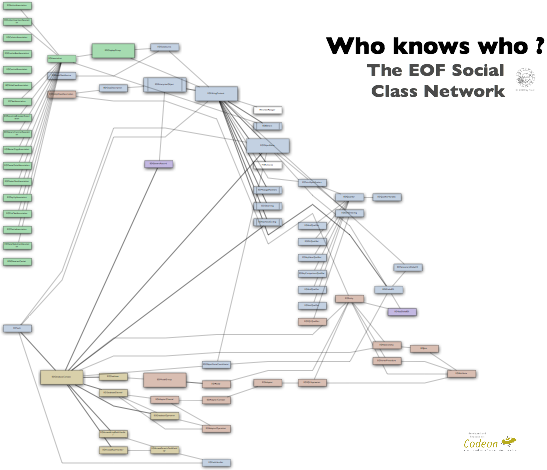EOF Wiki: Difference between revisions
No edit summary |
|||
| (70 intermediate revisions by the same user not shown) | |||
| Line 1: | Line 1: | ||
== Welcome == | == Welcome == | ||
[[ | This is the [[Objective-C EOF]] Wiki. It started as the [[MulleEOF]] wiki but soon after setting it up, it seemed to be a good idea to make it a more general EOF Wiki. If you have an [[Objective-C EOF]] clone or are looking for one: this is the place to be. | ||
This is | This Wiki is <b>wholly</b> unconcerned about Java-EOF as available through WebObjects 5 from Apple.From now on all references to [[EOF]] will always mean [[Objective-C EOF]] and Java will be ignored. | ||
If you are not that familiar with [[EOF]] and it's history, you can read a good historical overview on [http://en.wikipedia.org/wiki/Enterprise_Objects_Framework Wikipedia]. | |||
<i>Because of Spambots, you will have to register and confirm your email address, before you can change anything.</i> | |||
== | == Description == | ||
* [[ | EOF is commonly referred to as a database abstraction layer. And it is also a toolkit of various components that can be used independently. Even if your application doesn't access a database, it can pay off to get familiar with [[EOF]]. | ||
* [[ | |||
* [[ | [[Image:Layers.png]] | ||
* [[ | |||
[[EOF]] traditionally has been separated in three frameworks | |||
* [[EOControl]] the abstraction layer that provides the groundwork for the editing and persistance of objects | |||
* [[EOInterface]] the GUI component, that ties AppKit to [[EOControl]] | |||
* [[EOAccess]] for the concrete use of [[EOControl]]. It contains an [[EOObjectStore]] subclass, that uses one or multiple SQL databases for persistance | |||
Here's a look at the classes contained in those frameworks: | |||
[[Image:EOFClassesLayered.png]] | |||
Download the [http://www.project-titmouse.de/project-titmouse/EOFClassesLayered.pdf PDF] to look at it in detail. | |||
== Articles == | |||
{{:Articles}} | |||
== Documentation == | |||
{{:Documentation}} | |||
== Implementations == | |||
The original | |||
* [[EOF 4.5.1]] by Apple | |||
and the clones and relatives of EOF | |||
* [[AJRDatabase]] | |||
* [[GDL1]] | |||
* [[GDL2]] | |||
* [[MulleEOF]] | |||
* [[SOPE GDL1]] | |||
It'd be good to have a [[feature comparison chart]] at some point in time. | |||
== Related Projects and other Resources == | |||
{{:RelatedProjects and Resources}} | |||
Latest revision as of 14:20, 15 January 2008
Welcome
This is the Objective-C EOF Wiki. It started as the MulleEOF wiki but soon after setting it up, it seemed to be a good idea to make it a more general EOF Wiki. If you have an Objective-C EOF clone or are looking for one: this is the place to be.
This Wiki is wholly unconcerned about Java-EOF as available through WebObjects 5 from Apple.From now on all references to EOF will always mean Objective-C EOF and Java will be ignored.
If you are not that familiar with EOF and it's history, you can read a good historical overview on Wikipedia.
Because of Spambots, you will have to register and confirm your email address, before you can change anything.
Description
EOF is commonly referred to as a database abstraction layer. And it is also a toolkit of various components that can be used independently. Even if your application doesn't access a database, it can pay off to get familiar with EOF.
EOF traditionally has been separated in three frameworks
- EOControl the abstraction layer that provides the groundwork for the editing and persistance of objects
- EOInterface the GUI component, that ties AppKit to EOControl
- EOAccess for the concrete use of EOControl. It contains an EOObjectStore subclass, that uses one or multiple SQL databases for persistance
Here's a look at the classes contained in those frameworks:
Download the PDF to look at it in detail.
Articles
Articles about EOAccess
- Who is handling the restricted qualifier
- What cachesObjects on EOEntity can and can not do
- Storing NSDates and NSCalendarDates in a database
Articles about EOControl
- What problems can EOFault solve for you ?
- What is the entity concept in EOControl ?
- How to create a recursive EOQualifier.
- Why prefetching can be dangerous.
Articles about EOInterface
- How changes in EOEnterpriseObjects propagate to EOAssociations' subjectChanged details the control flow starting with [self willChange]
- Who retains who when a NIB is loaded
- MulleEOF and the NSRunLoop explains some of the nitty gritty behind the scenes stuff
- Creating a daterange search field
- EOOutlineViewAssociation
Some of these articles are not part of this Wiki and therefore also not part of the CC license.
Documentation
Documentation for EOF is available from Apple on the developer site.
Also some of these links may be helpful, as EOF became a part of WebObjects at some point in history
Most of these links are not part of this Wiki and therefore also not part of the CC license.
Implementations
The original
- EOF 4.5.1 by Apple
and the clones and relatives of EOF
It'd be good to have a feature comparison chart at some point in time.
Related Projects and other Resources
- BDControl qualifier and sort ordering
- MulleConnectInspector for Interface Builder 2.4
- EOF Mailinglist hosted by the Omnigroup extremely low traffic
- WikiBooks Programming:WebObjects a WebObjects Wiki for Java EOF/WebObjects

